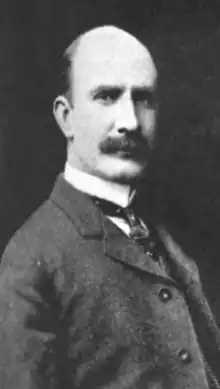Harris Hancock
Harris Hancock (May 14, 1867 – March 19, 1944) was a mathematics professor at the University of Cincinnati who worked on algebraic number theory and related areas. He was the brother of the horse breeder Arthur B. Hancock.
Harris Hancock | |
|---|---|
 | |
| Born | May 14, 1867 Albemarle County, Virginia |
| Died | March 19, 1944 (aged 76) Albemarle County, Virginia |
| Nationality | American |
| Alma mater | Johns Hopkins University University of Berlin University of Paris |
| Spouse |
Belle Lyman Clay (m. 1907) |
| Scientific career | |
| Fields | Mathematics |
| Institutions | University of Cincinnati |
| Thesis | Ein Form des Additionstheorem für Hyperelliptische Functionen erster Ordnung (1894) |
| Doctoral advisor | Lazarus Fuchs Hermann Schwarz |
Biography
Harris Hancock was born at his family's estate, Ellerslie, in Albemarle County, Virginia on May 14, 1867. He graduated from the University of Virginia's school of mathematics in 1886. He received an AB from Johns Hopkins University in 1888, an AM and PhD from the University of Berlin in 1894, and an ScD from the University of Paris in 1901.[1]
He married Belle Lyman Clay on September 30, 1907, and they had two children.[1]
Harris Hancock died at Ellerslie on March 19, 1944.[2]
Publications
Articles
- Hancock, Harris (1918). "Remarks on elliptic integrals". Bulletin of the American Mathematical Society. 24 (10): 487–489. doi:10.1090/S0002-9904-1918-03118-2. ISSN 0002-9904.
- Hancock, Harris (1919). "On the evaluation of the elliptic transcendence and ". Bulletin of the American Mathematical Society. 25 (4): 150–158. doi:10.1090/S0002-9904-1919-03168-1. ISSN 0002-9904.
Books
- Hancock, Harris (1904), Lectures on the calculus of variations, Cincinnati University Press
- Hancock, Harris (1910), Lectures on the theory of elliptic functions, John Wiley and Sons Reprinted by Dover Publications, Inc., New York 1958
- Hancock, Harris (1917), Elliptic integrals, John Wiley and Sons[3] Reprinted by Dover Publications, Inc., New York 1958
- Hancock, Harris (1917), Theory of maxima and minima, Ginn, MR 0114884[4] Reprinted by Dover Publications, Inc., New York 1960
- Hancock, Harris (1931), Foundations of the theory of algebraic numbers, vol. I and II, Macmillan[5] Reprinted by Dover Publications, Inc., New York 1964
- Hancock, Harris (1939), Development of the Minkowski geometry of numbers, Macmillan, ISBN 978-0486446462[6] Reprinted by Dover Publications, Inc., New York 1964, 2005
References
- The National Cyclopaedia of American Biography. Vol. XVI. James T. White & Company. 1918. p. 70. Retrieved December 9, 2020 – via Google Books.
- "Educator To Be Buried Today". The Cincinnati Enquirer. March 21, 1944. p. 11. Retrieved December 9, 2020 – via Newspapers.com.
- Carmichael, R. D. (1918). "Book Review: Elliptic Integrals". Bulletin of the American Mathematical Society. 24 (5): 252–254. doi:10.1090/S0002-9904-1918-03058-9. ISSN 0002-9904.
- Crathorne, A. R. (1920). "Book Review: Theory of Maxima and Minima". Bulletin of the American Mathematical Society. 26 (4): 180–183. doi:10.1090/S0002-9904-1920-03287-8. ISSN 0002-9904.
- Ore, Oystein (1933). "Book Review: Foundations of the Theory of Algebraic Numbers". Bulletin of the American Mathematical Society. 39 (9): 645–648. doi:10.1090/S0002-9904-1933-05685-9. ISSN 0002-9904.
- Brauer, Richard (1942). "Book Review: Development of the Minkowski Geometry of Numbers". Bulletin of the American Mathematical Society. 48 (9): 651–654. doi:10.1090/S0002-9904-1942-07728-7. ISSN 0002-9904.
- Moore, C.N. (1944), "Harris Hancock - In Memoriam", Bulletin of the American Mathematical Society, 50 (11): 812–815, doi:10.1090/S0002-9904-1944-08209-8
External links
This article is issued from Wikipedia. The text is licensed under Creative Commons - Attribution - Sharealike. Additional terms may apply for the media files.